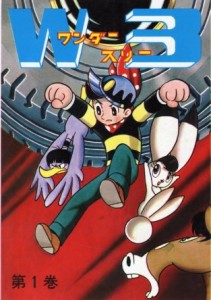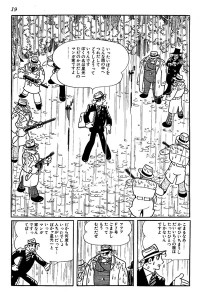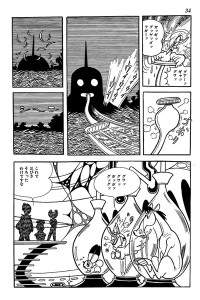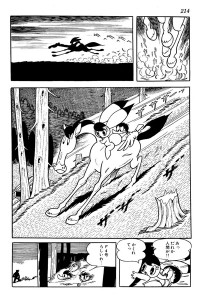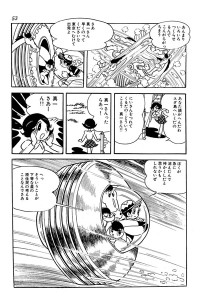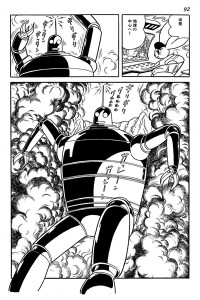Wonder 3 (Manga)
Also known as ワンダー3 (Wanda Suri)
| English Title: | Wonder 3 |
| In English? | No |
| Japanese Title: | ワンダー3 (Wanda Suri) |
| Type: | Ongoing Serial |
| Original run: Second run: |
1965/03/21 – 1965/04/25 1965/05/30 – 1966/05/08 |
| Published in: | Weekly Shonen Magazine 週刊少年マガジン Weekly Shonen Sunday 週刊少年サンデー |
| Published by: | Kodansha Shogakukan |
| Volumes: | 3 (MT-139 | MT-140 | MT-141) |
One of Tezuka’s most well-known sci-fi adventure series, Wonder 3 (1965-66), also sometimes known as Amazing 3, was originally published in Weekly Shonen Magazine in March and April of 1965 and then, after a short hiatus, was suddenly rebooted in Weekly Shonen Sunday, running from May 1965 to May 1966.
What it’s about
It is the year 196X. Experiments with hydrogen bomb technology continue and the entire world is at war. The situation on Earth, however, has not gone unnoticed by our cosmic neighbours and the members of the Milky Way Confederation convene a meeting deep in space to decide whether or not to use their superior technology to save the Earth from its own barbarism, or to simply wipe it out of existence with an anti-proton bomb. They conclude that more information is necessary, and dispatch three agents to Earth to investigate the situation.
So as to avoid detection, the originally humanoid agents are transformed to mimic the appearance of life forms captured from Earth. And so Captain Bokko (a rabbit), Nokko (a horse), and Pukko (a duck), collectively known as the “Wonder 3” (W3), arrive on Earth – specifically in a village called Ogawa-mura somewhere in the Japanese countryside. Soon after their arrival they meet a kind-hearted, if somewhat wild, boy named Shinichi Hoshi, and strike up a friendship.
Conveniently, Shinichi’s older brother, Koichi Hoshi, and unbeknownst to his family, just happens to be a member of the secret intelligence agency known as “Phoenix”. And sure enough, Shinichi and the W3 team soon find themselves embroiled in plots and machinations for global domination, and a fight for justice that takes them around the world.
Along the way, the W3 team tackles issues of poverty and the environment, and, through their relationships with the Hoshi brothers, gradually begin to realize that the Earth is not simply the barbarous planet they originally thought it was. It might even be worth saving.
What you should know
Wonder 3 (1965-66) is unique among Tezuka’s works in that it is the only animated television series to “inspire” (given that the stories are all different) a related manga series, instead of the other way around. The reason for this is fairly complex.
In 1964, with Japan’s first animated television series, Astro Boy (1963-66) entering its second year, new companies began entering into the television animation industry one after another. At the same time, given the success of Astro Boy (1963-66), Mushi Productions’ staffing had grown to include several hundred people. With a “family” that size, Tezuka decided that Mushi Productions needed to begin planning work on new animated television series in parallel with their work on Astro Boy (1963-66). The first of these was Jungle Emperor (1965-66), Japan’s first full-colour animated television series. The other one targeted for production, was Number 7 (1961-63), a sci-fi action manga series that had been serialized in the publication Rising Sun.
Mushi Productions quickly began working on Number 7, and things were proceeding relatively smoothly and a pilot episode was almost complete when Tezuka suddenly slammed on the brakes. According to an article Tezuka wrote around that time (published in the September 1965 issue of Astro Boy Club), Mushi Pro had received word that another animation company had a television show with a similar concept in development. The show in question would later be revealed as Toei’s Rainbow Sentai Robin (1966-67). Although there were similarities, for example both series featured a team of seven heroes (including a robot) fighting threats in outer space, they could generally be chalked up to the less-than-unique setup. However, Tezuka, never one to take a challenge to his work lying down, couldn’t be convinced to continue with the status quo and decided to retool his series instead.
Given the boom in the “ultra cool spy” genre (largely due to another series with the number “7” in it… 007 to be precise), Tezuka decided to have his main hero, Koichi Hoshi, engage in secret agent-type activities. He also decided that, in order to appeal to a younger audience, he should add a mascot. And so, Bokko the Space Squirrel, with his abilities to speak telepathically, fly, emit lasers and turn invisible, was added to the roster as Koichi’s side-kick.
So, despite a few stumbling blocks, Number 7 was back on track.
Around the same time Tezuka also received a request from Weekly Shonen Magazine to begin serialization of the manga version of his new series beginning in the March 21, 1965 edition (vol. 13) – slightly before the debut of the TV anime. Tezuka agreed, and for Weekly Shonen Magazine this was the fulfillment of a wish the magazine had had – to acquire an Osamu Tezuka series – since it’s very first edition.
However, in late December 1964 there was more controversy. Information came to light that yet another animation company was planning a television show with a very similar concept – the TBS series Space Boy Soran (1965-67), complete with “Chappy the Space Squirrel” a near-perfect clone of Bokko. While Rainbow Sentai Robin (1966-67) could be explained away as mere coincidence, in this case, allegations of industrial espionage quickly surfaced.
At first Weekly Shonen Magazine’s editorial department was suspected of being the source of the leak, however with nothing to be gained (and given the fact that they hadn’t seen Bokko yet), suspicion soon turned to a young staffer who had worked at Mushi Productions, and recently left to join TBS – Toyota Aritsune. Yet, despite a lot of finger pointing, and some name calling, it was not clear if this was a case of a malicious mercenary intent on cashing in, or simply the honest mistake of a young man dropping too much information at a party while trying to look cool.
Either way, it was back to the drawing board for Tezuka and his staff at Mushi Productions.
His response was to change the squirrel into a rabbit (keeping the name at least intact), and make her the leader of a trio of space aliens disguised as Earth creatures (along with a horse and a duck). The protagonist role was also shifted to Shinichi, although his now older brother Koichi Hoshi still got to be a secret agent (complete with the inside-joke code name “F7”), thereby holding on to at least some remnant of the retooled Number 7 era.
All in all, Tezuka ended up with a much stronger sci-fi concept, and the new series Wonder 3 (1965) debuted without missing a beat in the March 21, 1965 edition (vol. 13) of Weekly Shonen Magazine as expected – with the animated television series hot on its heels.
However, controversy soon reared its ugly head once again.
To add insult to injury, Tezuka discovered that Wonder 3 (1965) was going to be serialized right alongside the manga version of Space Boy Soran (1965-66) in Weekly Shonen Magazine beginning with vol. 20 – something which was unforgivable to Tezuka. He demanded that Weekly Shonen Magazine’s editorial group rescind their plans to publish Soran. But when his protests fell on deaf ears, Tezuka decided to take matters into his own hands. A mere six installments into the serial, Tezuka packed up shop, made a few improvements to the concept, and rebooted Wonder 3 (1965-66) without skipping a beat at Weekly Shonen Magazine’s fierce rival – Weekly Shonen Sunday in May 1965.
According to the editor at the time, Teruo Miyahara, Weekly Shonen Magazine had tried to explore options for reconciliation, but Tezuka’s unilateral decision to move Wonder 3 (1965-66) to Weekly Shonen Sunday had made that impossible. For his part, Tezuka cited “Mushi Productions’ situation” and “complex advertising industry relationships” (given that Wonder 3 was sponsored by Lotte while Space Boy Soran was sponsored by Morinaga, two rival confectionery giants) as the primary reasons for the sudden move.
It is interesting to note though, that the man responsible for the manga version of Space Boy Soran (1965-66) was Miyakoshi Yoshikatsu, a former disciple of Tezuka’s.
Whatever the case, Tezuka’s relationship with Kodansha (one of the major Japanese publishers) was damaged by the abrupt departure, causing them to declare that Osamu Tezuka’s manga was never to appear in Weekly Shonen Magazine. In fact, despite a couple of short stories in 1969 and 1970 for a sibling magazine [Bessatsu Shonen Magajin], it was almost 10 years before the ban was lifted.
In 1974, Tezuka finally returned to Weekly Shonen Magazine, first with another short story and then with another hit series, The Three-Eyed One (1974-78). This set the stage for Kodansha to approach Osamu Tezuka a few years later with a proposal to publish a complete library of nearly all his manga works –the Osamu Tezuka Complete Manga Works. Ironically, it was this series that gave Tezuka the opportunity to finally put the whole matter to rest in 1983. In the afterword to the Osamu Tezuka Complete Manga Works edition (MT-141), Tezuka suggested that no one was to blame for the incident, and he apologized to Kodansha for having caused them any trouble… however it should be noted that it wasn’t until 2009 when Kodansha re-released a revised version of the Complete Manga Works, that the original, aborted, six installments of Wonder Three (1965) were finally reprinted.
Finally, on a completely different note, readers may be interested to know that Wonder 3 (1965-66) also features appearances by some of Tezuka’s friends: Mr. Baba, the teacher is modeled after manga artist Noboru Baba, and the hero of the story, Shinichi Hoshi, is named after the SF writer Shinichi Hoshi.
Oh, and the animation Mushi Productions produced based on the original Number 7 manga before the series was retooled into oblivion? It wound up being repurposed for an episode of Astro Boy (1963-66).

